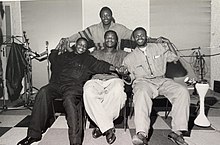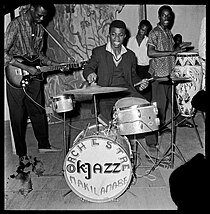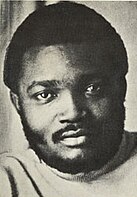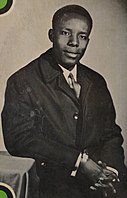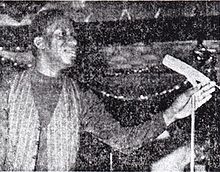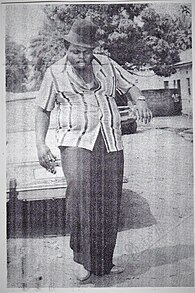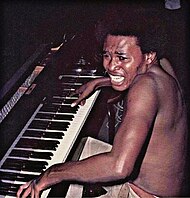
Congolese music is one of the most influential music forms of the African continent. Since the 1930s, Congolese musicians have had a huge impact on the African musical scene and elsewhere. Many contemporary genres of music, such as Kenyan Benga and Colombian Champeta, have been heavily influenced by Congolese music. In 2021, Congolese rumba joined other living traditions such as Jamaican reggae music and Cuban rumba on UNESCO's "intangible cultural heritage of humanity" list.

Jules Shungu Wembadio Pene Kikumba, known professionally as Papa Wemba, was a Congolese singer and musician who played Congolese rumba, soukous, and ndombolo. Dubbed the "King of Rumba Rock", he was one of the most popular musicians of his time in Africa and played an important role in world music. He was also a fashion icon who popularized the Sape look and style through his musical group Viva la Musica, with whom he performed on stages throughout the world.

African popular music, like African traditional music, is vast and varied. Most contemporary genres of African popular music build on cross-pollination with Western popular music. Many genres of popular music like blues, jazz, salsa, zouk, and rumba derive to varying degrees on musical traditions from Africa, taken to the Americas by enslaved Africans. These rhythms and sounds have subsequently been adapted by newer genres like rock, and rhythm and blues. Likewise, African popular music has adopted elements, particularly the musical instruments and recording studio techniques of the Western music industry. The term does not refer to a specific style or sound but is used as a general term for African popular music.

Antoine Christophe Agbepa Mumba, known professionally as Koffi Olomidé, is a Congolese singer-songwriter, dancer, producer, and founder of Quartier Latin International. Often referred to as the "King of Ndombolo", he is noted for his explosive high notes, deep baritone, and offbeat voice. Agbepa is considered one of the most significant figures in 20th-century Congolese and African popular music. His lyrics often explore themes of love, politics, technology, success, infidelity, religion, chicanery, and disillusionment. Through his music and stage performances, he introduced the slower style of soukous known as Tcha Tcho and popularized a flamboyant fashion subculture called La Sape, alongside Papa Wemba.

Ndombolo, also known as dombolo, is a genre of dance music originating in the Democratic Republic of the Congo. Derived from soukous in the 1990s, with fast-paced hip-swaying dance rhythms, often accompanied by upbeat, percussion-driven music, the style became widespread in the mid-1990s and the subsequent decade, dominating dancefloors in central, eastern, and western Africa. It inspired West African popular music, coupé-décalé, Kuduro, and East African dance music.
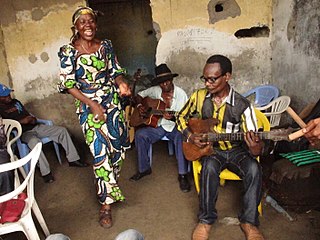
Congolese rumba, also known as African rumba, is a dance music genre originating from the Republic of the Congo and Democratic Republic of the Congo. With its rhythms, melodies, and lyrics, Congolese rumba has gained global recognition and remains an integral part of African music heritage. In December 2021, it was added to the UNESCO list of intangible cultural heritage.
Bisso Na Bisso is a music collective originating from the Republic of the Congo. The group was formed in 1999 and consists of rappers and singers, including Ben-J, a member of Les Neg'Marrons; the duo Lino and Calbo from Ärsenik; Doc and G Kill, renowned members of 2Bal; Mystik; and the only female rapper, M'Passi. The group was put together by the French rapper Passi.

Antoine Wendo Kolosoy, known as Papa Wendo, was a Congolese musician. He is considered the "doyen" of Congolese rumba, a musical style blending traditional Kongolese rhythm and son cubano.
Viva La Musica is a popular band from Zaire founded by singer Papa Wemba in 1977. While Viva La Musica started out as a soukous band, it eventually grew into a world music act, reaching some popularity and success in the European, American, and even Asian markets, as well as in most of Africa. The band is still active today, although it is just one of a number of musical ensembles used by Papa Wemba as a backup for his essentially soloist production.

Fally Ipupa N'simba, known professionally as Fally Ipupa, is a Congolese singer-songwriter, dancer, philanthropist, guitarist, and producer. Often referred to as the "Prince of Rumba", he is noted for his tenor vocals as well as his blend of contemporary and traditional Congolese music genres, including Congolese rumba, soukous, and ndombolo. His lyrics often cover themes of romance, suffering, and joy.
Innocent Didace Balume, known professionally as Innoss'B, is a Congolese singer-songwriter, rapper, percussionist, dancer, and philanthropist. Often referred to as the "Jeune Leader," he is renowned for pioneering the AfroCongo music genre, an eclectic fusion of Congolese rumba, indigenous folklore, and ndombolo.
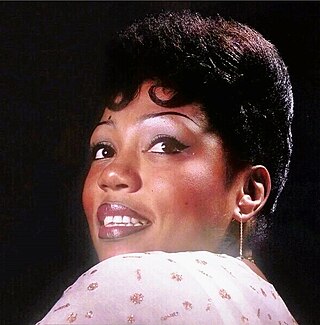
Elisabeth Finant, cognomenously known as Abeti Fina‐Masikini or simply Abeti Masikini, was a Congolese singer, composer, bandleader, and philanthropist. With a nearly three-decades-long career, she was a significant figure in 20th-century Congolese and African popular music. Often referred to as the "Queen of Soukous", she is noted for advocating gender equality, modernizing Congolese music, and inspiring successive generations of musicians. Her band, Les Redoutables, was a launching pad for numerous female artists.

Candy Nkunku, known professionally as Cindy Le Coeur, is a Congolese recording artist, singer, and dancer. She is a member of the Congolese band Quartier Latin International, formed and led by prolific musician Koffi Olomide.

Hervé Gola Bataringe, known professionally as Ferré Gola or Ferre Gola, is a Congolese singer-songwriter, dancer, and record producer. Revered as the "Jésus de Nuances", he is regarded as one of the most significant figures of the fifth-generation Congolese rumba. His lyrics predominantly revolve around themes of love, social support, and interpersonal relationships.
Kekele was a band formed in 2000, composed of leading veteran African musicians, mostly from the Democratic Republic of the Congo. They played Congolese rumba in a revival style harkening back to the 1950s, 60s, and 70s, using acoustic guitars. Kekele seems to be dormant or defunct, having not released a recording since 2006 nor performed since (apparently) 2010.
Defao was a Congolese singer-songwriter. He was a member of the prominent soukous groups Grand Zaiko Wawa and Choc Stars.

Jolie Detta Kamenga Kayobote, professionally known as Jolie Detta or Evangeliste Myriam, is a Congolese singer-songwriter, dancer, and evangelist. She made her music debut as a member of Choc Stars between 1983 and 1984. Detta later joined Tabu Ley's Orchestre Afrisa International in 1985 and then Franco Luambo's Ok Jazz in 1986, where she garnered national acclaim as the lead vocalist in the band's Extended Play (EP) Le Grand Maitre Franco et son Tout Puissant O.K. Jazz et Jolie Detta, in collaboration with Franco and Simaro Lutumba. The EP featured hit singles "Massu," "Cherie Okamuisi Ngai," "Layile," and "Likambo Ya Somo Lumbe," catapulted her into the limelight with a debut tour to Kenya with OK Jazz the same year. She later rejoined Choc Stars and recorded successful releases before joining Bozi Boziana's newly established ensemble Orchestre Anti-Choc in 1988 after Choc Stars disbanded. Anti-Choc's album La Reine de Sabah, released at the end of 1988, and its eponymous lead single, composed by Boziana, was named the Best Song of the Year and earned her the Best Voice of the Year for her performance.
Félix Nlandu Wazekwa, known professionally as Félix Wazekwa, is a Congolese singer-songwriter, author, filmmaker, dancer, and bandleader. Known for his Lingala deep lyrics and baritone voice, he is regarded as an influential figure in soukous and Congolese rumba music and one of the most prominent lyricists of his generation.
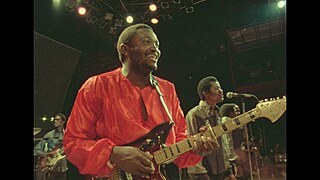
Sebene, also known as seben, is an instrumental section commonly played in Congolese rumba. It is usually played towards the end of the song and is the dancing section where the lead and rhythm guitars take the lead in the dance. It is characterized by the repetition of a specific number of notes during the passage of second chords: one major chord and one-seventh chord, which gives rise to the Lingala derivation "sebene," derived from the English numeral "seven" or its ordinal rendition.
